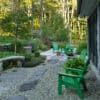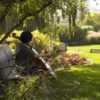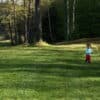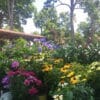Even when you live close to nature in one of the prettiest states in the country, it’s great to find inspiration and new insights in places of grandeur and beauty that you’ve never been before.

The Yellowstone River. Photo: Julie Messervy.
As someone whose job takes her to wonderful places all the time, I often forget to take a real vacation that’s not associated with work in any way. My husband, Steve Jonas, two good friends—Abbe Meiling and Jerry Ward—and I have come out West to experience the big skies, fresh air, and vast vistas in the corners of Utah, Idaho, Montana, and Wyoming. Here’s a short chronicle of our exploits.
L: Hillsides of wildflowers; R: Snowfields in Targhee National Forest. Photos: L: Julie Messervy; R: Steve Jonas.
After a grueling day of travel to Salt Lake City, we drove north into Idaho and Wyoming to hike seven miles into the Targhee National Forest. Everywhere I looked were wildflower meadows woven of columbine, geranium, windflower, and whole vast hillsides of yellow daisies located 8,000 feet above sea level. I’ll never see—or design–meadows the same way again. Each view included streams, waterfalls, and snowfields below the jagged peaks of the grand Tetons.

Chico Hot Springs. Photo: Julie Messervy.
We then drove on to Montana, through Boseman and stopped for a hike and dinner at Chico Hot Springs. Tucked into a narrow canyon forty miles north of Yellowstone National Park, Chico draws a diverse group to its hot pools, pretty gardens, and charming cabins.

L: Mammoth Hot Springs; R: Tower Fall. Photos: Julie Messervy.
Yellowstone National Park gives us a glimpse into the world below the earth’s crust. The park is the world’s largest hotbed of geothermal activity, with a 30 by 45 mile caldera–a collapsed volcano—at its heart. Throughout this simmering basin, you come upon mudpots, fumaroles, geysers, and hotsprings that erupt nearly under your feet, while bison and elk roam freely, and you can spot grizzly and black bear.

L: The Grand Canyon of the Yellowstone; R: Yellowstone Park hot pool. Photos: Julie Messervy.
At the north edge of the caldera is the Grand Canyon of the Yellowstone—a thousand-foot-deep chasm of incredible colors created by hot water flowing over volcanic rock. Elsewhere, you can visit subalpine meadows and Lodgepole Pine, covering 60% of the park, along with spruce, and fir forests that create a surprisingly lush landscape.

L: Salt lick attracts a moose; R: The Snake River. Photos: Steve Jonas.
Then we crossed the Continental Divide and drove back south along the Tetons, now to our west. We stopped briefly at the lovely Jenny Lake that mirrors the Grand Teton and drove on to Jackson, Wyoming, a bustling and prosperous town where we stayed at a friend’s house near Teton Village. We explored the town, hiked along the Snake River, played tennis, and watched wildlife—eagles, osprey, and a young moose who visited the salt lick behind our house. A new kind of focal point for a garden!

Rafting on the Snake River. Photo: Julie Messervy.
To satisfy our appetite for adventure we took a wild two-hour river rafting trip down the Snake against a howling gale force wind in a small 8-man raft. With our guide Ryan at the helm we deftly maneuvered through the Class 2 and Class 3 rollers, rapids, shelves, holes, and tongues of standing waves that drenched me through and through. Being this active every day by getting immersed—literally!—in nature is vital to physical, mental, and spiritual health. I’ll hope to continue it on my return home next week.

Jerry scattering his father’s ashes. Photo: Julie Messervy.
Steve and I are continuing on to see friends at Paeonia, Colorado. We ended this leg of our trip by scattering a few of the ashes of Jerry’s father on a pond next to the Snake River with the Teton range towering above—a place of inspiration for his father long ago. Here is Jerry’s Ode to Dad.
William Hamlin Ward (1928-2009)
Nearly, merely a lifetime ago
this water briefly nourished your soul
in ways I’ll never know.
You, of course, plied other waters
in humble crafts,
mostly reverently, occasionally recklessly,
always thoughtfully with abiding wit.
You went on to nourish other souls,
including my own,and left the world a slightly better place.
That was enough for you.
Nearly, merely a lifetime later,
I release your remains as you wished
into this Teton water
to again nourish your soul
in ways I’ll never know.
Jerry Ward
13-July -2010







What a beautiful way to remember your father.
Thank you for sharing your tribute to him.
What a beautiful spot and tribute. Thanks for sharing with us.
Your journey and your poem are both wonderful tributes, Jerry. Thank you…
Jerry, that was very sweet of you to fulfill your father’s wishes. Smiling tears fill me. Thanks.
Jerry, a well-done tribute to my Uncle Bill. I was lucky to spent some precious times with him on some of his waters. What I learned aboard “The Rockless” was that it was my job as the first mate to get the captain a beer on our way to the fishing hole.
The Tetons with Lake Jenny is a majestic site and fitting resting place.
As a quality blog about Landscape, it is very beautiful. Using images such as : Rafting on the Snake River, very beautiful. Thanks for nice posting.
Jerry: Your heartfelt ode is is a touching memorial to your father. Thanks for sharing it with us.